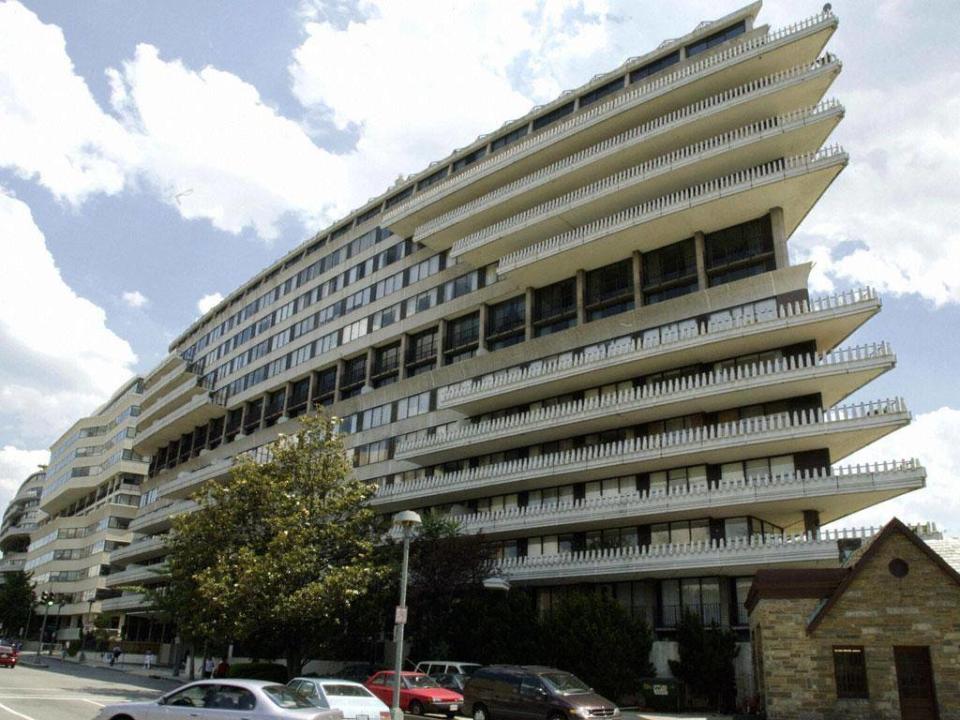The DNC's lawsuit against Trump, Russia and Wikileaks is making the parallels with Watergate hard to ignore

The Democratic Party’s abrupt dropping of a multi-million-dollar lawsuit into the simmering cauldron that is the Trump-Russia affair took some folk by surprise.
Why risk complicating the life of special counsel Robert Mueller just when he may be getting to the endgame of his own investigation into all these allegations? Where did such a crazy idea come from anyway?
Watergate, that’s where. In fact, scholars of that especially dark time, which eventually forced Richard Nixon from office, were asking a different question. How come the Democratic National Committee (DNC), which filed the suit against the Trump campaign, Wikileaks and the Russian Federation in a New York federal court on Friday, had taken so long about it?
They were a lot quicker off the mark last time. It was 17 June 1972 when burglars in business suits were arrested in the offices of the DNC at the Watergate complex in Washington DC, as they attempted to place bugging devices and photograph documents in the hope of gathering damaging information on Nixon’s opponents. Just four days later the DNC swung into legal attack mode.
On 21 June, Lawrence O’Brien, the then DNC chairman, announced a $1m lawsuit against the Committee for the Re-Election of the President. It would be a full two years before Nixon boarded Marine One for the last time, yet O’Brien even then spoke of “a developing clear line to the White House,” from the arrest of the five burglars. “This is not partisan, it’s patriotic … It is our obligation to the American people,” he declared. Nixon’s campaign chairman, John Mitchell, was, naturally, unimpressed and labelled the suit “another example of sheer demagoguery”.
This time the DNC is merely peddling “a left-wing conspiracy theory”, or so declared Roger Stone, a Trump associate and one of those named as defendants along with a now familiar cast of characters. They include former campaign chairman Paul Manafort and Trump’s son-in-law, Jared Kushner. “NO proof or evidence,” Stone wrote in a defiant email to Reuters.

It may not enlighten much, but the urge to compare Trump’s legal peril with Watergate has been irresistible almost since the moment he fired his FBI Director, James Comey, nearly a year ago. (We have been hearing a lot from Comey lately, as you know.) I was in the room on 16 May when Senator John McCain did exactly that at a Republican Party dinner in Washington. “We’ve seen this movie before. It’s reaching Watergate size and scale,” he said. “This is not good for the country.” Afterwards he told me he hadn’t meant to take the parallels quite that far.
But it’s always been hard not to recognise them. Both scandals began with burglaries and invasion of DNC property. Forty-five years ago, it was physical in nature – locks picked and door latches taped for easy escape. In 2016, as the new lawsuit makes clear, a cyber crime was reported. With “gleeful” enthusiasm, it alleges, the Trump campaign encouraged Russia and its intelligence community to break into the DNC’s servers and telephone systems, this time to dig up anything that could hurt Hillary Clinton and thereby assist Trump’s run for the highest office.
“During the 2016 presidential campaign, Russia launched an all-out assault on our democracy and it found a willing and active partner in Donald Trump’s campaign,” Tom Perez, today’s DNC Chairman, asserted in a statement. “This constituted an act of unprecedented treachery.”

We may be short of reaching Watergate “size and scale” because we don’t yet have anything to match the so-called “Saturday Night Massacre” moment of 19 October 1973, when the then special prosecutor Archibald Cox issued a subpoena for copies of tapes made by Nixon in the Oval Office and the president reacted by firing him. First he had to find someone in the Justice Department to carry out the firing and the first two candidates refused and resigned. They were Attorney General Elliot Richardson and Deputy Attorney General William Ruckelshaus.
The threat of history repeating itself is what keeps Trump and his aides up at night. Some of it already has, including Friday’s court filing by the DNC. But what terrifies his legal advisers more than anything else is Trump giving the process a huge nudge forward by falling into one very big and obvious “Saturday-Night-Massacre” trap –by attempting to fire Mueller just like Nixon fired Cox.
That Trump would like to is no secret to anyone. Just last month he went after Mueller and his ongoing probe in one of his early morning Twitter rants. “A total WITCH HUNT with massive conflicts of interest!” he thundered. But the warnings of the dire consequences such an action would have continue to come at him from all quarters, including from Republicans on Capitol Hill. “If he tried to do that, that would be the beginning of the end of his presidency,” South Carolina Republican Senator Lindsay Graham recently predicted to CNN.
If Trump doesn’t care to pay attention to history, then clearly the DNC and Tom Perez are. The lawsuit filed by O’Brien all those years back may have come off as over-hasty and half-baked, but it worked. The DNC collected $750,000 from the Nixon campaign. On the day he left office.

 Yahoo News
Yahoo News 
